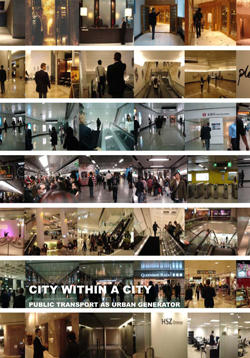CITY WITHIN A CITY - Public Transport as Urban Generator

Students: Manuel Guth, Chasper Schmidlin
in collaboration with CUHK Students Shuk Fun Sophie Chan, Kai Yan Cye Wong
Location: Group work in Hong Kong
Date: June, 2008
Type: Research project, student work, public transport as urban generator
Hong Kong is a rare case of a metropolis that almost exclusively relies on its public transport system and with little exaggeration it can be described as a ‘city without cars.' 90% of transportation in Hong Kong is public, as well as the 50% of its total car mobility. It is the metropolis with the lowest private car ownership in the world, while at the same time it is perceived as ‚the most pedestrian friendly city in the world‘.
Hong Kong’s contemporary city form evolves from integration of urban flows and density. Together with HKSAR Government, transport companies are key actors in urban development of Hong Kong – transport planning is used as a tool to generate profit through real-estate development, while the challenging topography of mountains and archipelago of islands additionally contribute to the creativity of transport engineering. The metro transport of Hong Kong and the fast train links to the cities of the PRD were operated by 2 companies, MTRC and KCR, that have recently been privatized and merged.
Since the late '90s, the combined development of transport infrastructure with the points of high-density accumulation has produced some of the typical and specific architectural and urban forms of Hong Kong – giant infrastructural hubs or megaforms – perceived and described as ‘vertical cities’ or ‘autonomous cities’. Typologically these megaforms can vary around a basic model of a ‘podium’ with infrastructural transferia underneath and vertical amassing of programs above, including shopping malls, offices and housing. In Hong Kong, the relationship of metro and train stations with the city is specific too. While in cities such as Tokyo and Singapore, stations have a more direct connection to the space of the street, in Hong Kong, interconnected worlds of hi-speed movement, shopping, working and living produce an extended urban interior and an experience of a ‘city within a city’, in which it seems that one could fulfil every need without ever exiting back into the street. The city fabric of Hong Kong is older and grew without the hyper-efficient ‘linear cities’ of infrastructure - the relation between these two models of urbanisation will be one of the points of interest of the work.
Download the Book PDF

